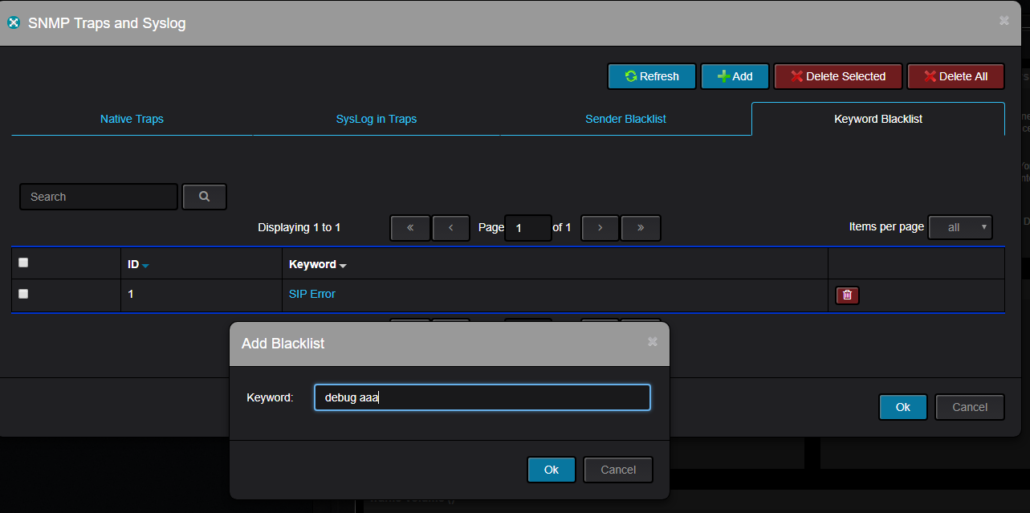| Platform_id |
Product_name |
Product_category |
| .1.3.6.1.4.1.2496.1.1 |
Cisco PGW 2200 Softswitch |
Cisco Protocol Gateways |
| .1.3.6.1.4.1.4413.2.1.6 |
Motorola Surfboard SBG6580 Cable Modem and Wireless Router |
Motorola Cable Modem and Wireless Routers |
| .1.3.6.1.4.1.99.1.1.3.34 |
Cisco Virtual PSTN Gateway |
Cisco Virtual PSTN Gateways |
| .1.2.826.0.1.4616240.1.1.4515 |
Cisco TelePresence MCU 4515 Multiparty Conferencing Unit |
Cisco TelePresence MCU 4500 Series Video Conferencing Units |
| .1.2.826.0.1.4616240.1.1.4505 |
Cisco TelePresence MCU 4505 Multiparty Conferencing Unit |
Cisco TelePresence MCU 4500 Series Video Conferencing Units |
| .1.2.826.0.1.4616240.1.1.4501 |
Cisco TelePresence MCU 4501 Multiparty Conferencing Unit |
Cisco TelePresence MCU 4501 Series Video Conferencing Units |
| .1.2.826.0.1.4616240.1.1.4210 |
Cisco TelePresence MCU 4210 Multiparty Conferencing Unit |
Cisco TelePresence MCU 4200 Series Video Conferencing Units |
| .1.2.826.0.1.4616240.1.1.4205 |
Cisco TelePresence MCU 4205 Multiparty Conferencing Unit |
Cisco TelePresence MCU 4200 Series Video Conferencing Units |
| .1.3.6.1.4.1.9.1.2141 |
Cisco cBR-8 Converged Broadband Router |
Cisco cBR Series Converged Broadband Routers |
| .1.2.826.0.1.4616240.1.1.4220 |
Cisco TelePresence MCU 4220 Multiparty Conferencing Unit |
Cisco TelePresence MCU 4200 Series Video Conferencing Units |
| .1.2.826.0.1.4616240.1.1.4510 |
Cisco TelePresence MCU 4510 Multiparty Conferencing Unit |
Cisco TelePresence MCU 4500 Series Video Conferencing Units |
| .1.2.826.0.1.4616240.1.1.4215 |
Cisco TelePresence MCU 4215 Multiparty Conferencing Unit |
Cisco TelePresence MCU 4200 Series Video Conferencing Units |
| .1.2.826.0.1.4616240.1.1.4203 |
Cisco TelePresence MCU 4203 Multiparty Conferencing Unit |
Cisco TelePresence MCU 4200 Series Video Conferencing Units |
| .1.3.6.1.4.1.9.1.2008 |
Cisco C897VA Integrated Servises Router |
Cisco 890 Series Integrated Services Routers |
| .1.3.6.1.4.1.9.1.2229 |
Cisco C841M-4X Integrated Services Router |
Cisco 800M Series Integrated Services Routers |
| .1.3.6.1.4.1.9.1.973 |
Cisco UC520-S8-U2-BRIWK9J Switch |
Cisco 520 Series Switches |
| .1.3.6.1.4.1.9.1.888 |
Cisco UC520-M48-U12-FXO Switch |
Cisco 520 Series Switches |
| .1.3.6.1.4.1.9.1.2250 |
Cisco Aironet 1850 Access Point |
Cisco Aironet 1850 Series Access Points |
| .1.3.6.1.4.1.9.1.931 |
Cisco RF Gateway 10 |
Cisco Universal Edge QAM |
| .1.2.826.0.1.4616240.1.1.4520 |
Cisco TelePresence MCU 4520 Multiparty Conferencing Unit |
Cisco TelePresence MCU 4500 Series Video Conferencing Units |
| .1.3.6.1.4.1.9.1.594 |
Cisco 1718 Router |
Cisco 1700 Series Routers |
| .1.3.6.1.4.1.9.1.1860 |
Cisco C891FW Integrated Services Router |
Cisco 890 Series Integrated Services Routers |
| .1.3.6.1.4.1.9.1.1056 |
Cisco SM-X Layer 2/3 EtherSwitch Service Module |
Cisco EtherSwitch Modules |
| .1.3.6.1.4.1.9.1.1397 |
Cisco 881 Integrated Services Router |
Cisco 880 Series Integrated Services Routers |
| .1.2.826.0.1.4616240.1.1.8510 |
Cisco TelePresence MCU MSE 8510 Multiparty Conferencing Unit |
Cisco TelePresence MCU MSE Series Video Conferencing Units |
| .1.3.6.1.4.1.11829 |
Corvil CorvilProbe CNE5100 CorvilNet Engine Software |
Corvil CorvilProbe CNE5100 CorvilNet Engine Software |
| .1.3.6.1.4.1.9.1.1384 |
Cisco C819 Integrated Services Router |
Cisco 819 Series Integrated Services Routers |
| .1.3.6.1.4.1.9.1.1854 |
Cisco C886VA Integrated Services Router |
Cisco 880 Series Integrated Services Routers |
| .1.3.6.1.4.1.9.1.2058 |
Cisco 887VA Integrated Services Router |
Cisco 880VA Series Integrated Services Routers |
| .1.3.6.1.4.1.9.1.1746 |
Cisco VG202XM Voice Gateway |
Cisco VG Series Gateways |
| .1.3.6.1.4.1.9.1.1882 |
Cisco Catalyst 3650-48TQ-E Switch |
Cisco Catalyst 3650 Series Switches |
| .1.3.6.1.4.1.9.1.2230 |
Cisco C841M-8X Integrated Services Router |
Cisco 800M Series Integrated Services Routers |
| .1.3.6.1.4.1.9.1.2130 |
Cisco Catalyst 3560CX-8PT-S Switch |
Cisco Catalyst 3500 Series Switches |














